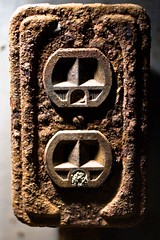
- Image by Dim Sum! via Flickr
From Tim Greene’s “Black Hat set to expose new attacks” (Network World: 27 July 2009):
Black Hat USA 2009, considered a premier venue for publicizing new exploits with an eye toward neutralizing them, is expected to draw thousands to hear presentations from academics, vendors and private crackers.
For instance, one talk will demonstrate that if attackers can plug into an electrical socket near a computer or draw a bead on it with a laser they can steal whatever is being typed in. How to execute this attack will be demonstrated by Andrea Barisani and Daniele Bianco, a pair of researchers for network security consultancy Inverse Path.
Attackers grab keyboard signals that are generated by hitting keys. Because the data wire within the keyboard cable is unshielded, the signals leak into the ground wire in the cable, and from there into the ground wire of the electrical system feeding the computer. Bit streams generated by the keyboards that indicate what keys have been struck create voltage fluctuations in the grounds, they say.
Attackers extend the ground of a nearby power socket and attach to it two probes separated by a resistor. The voltage difference and the fluctuations in that difference – the keyboard signals – are captured from both ends of the resistor and converted to letters.
This method would not work if the computer were unplugged from the wall, such as a laptop running on its battery. A second attack can prove effective in this case, Bianco’s and Barisani’s paper says.
Attackers point a cheap laser at a shiny part of a laptop or even an object on the table with the laptop. A receiver is aligned to capture the reflected light beam and the modulations that are caused by the vibrations resulting from striking the keys.
Analyzing the sequences of individual keys that are struck and the spacing between words, the attacker can figure out what message has been typed. Knowing what language is being typed is a big help, they say.
